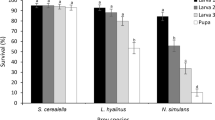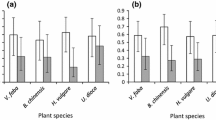Abstract
We compared the development and survival of Coccinella septempunctata bruckii Mulsant and Propylea japonica (Thunberg) raised on Uroleucon nigrotuberculatum (Olive) with those of the same species raised on Megoura crassicauda Mordvilko. Uroleucon nigrotuberculatum significantly prolonged the development time and drastically reduced the survival of the larval stages of both predators. Adult body weight of C. septempunctata and females of P. japonica raised on M. crassicauda was substantially heavier. No females of C. septempunctata raised on U. nigrotuberculatum laid eggs. Only 15 % of C. septempunctata females collected from Solidago altissima L. patch laid eggs for 48 h when fed on U. nigrotuberculatum. In contrast, females fed on M. crassicauda were highly fecund. Some P. japonica females raised on U. nigrotuberculatum laid a few eggs discontinuously for a short period. Approximately 90 % of P. japonica adult females collected from the solidago patch and fed on U. nigrotuberculatum laid a few eggs, but females fed on M. crassicauda laid substantially more eggs. These results suggest that patches of the introduced plant solidago, a natural host of the introduced aphid, U. nigrotuberculatum, are not adequate habitats for reproduction but may provide lady beetle adults with alternative prey on which to survive when suitable prey are scarce.





Similar content being viewed by others
References
Ando Y, Utsumi S, Ohgushi T (2011) Community-wide impact of an exotic aphid on introduced tall goldenrod. Ecol Entomol 36:643–653. doi:10.1111/j.1365-2311.2011.01303.x
Bianchi FJJA, van der Werf W (2004) Model evaluation of the function of prey in non-crop habitats for biological control by ladybeetles in agricultural landscapes. Ecol Model 171:177–193. doi:10.1016/j.ecolmodel.2003.08.003
Bianchi FJJA, Booij CJH, Tscharntke T (2006) Sustainable pest regulation in agricultural landscapes: a review on landscape composition, biodiversity and natural pest control. Proc Biol Sci 273:1715–1727. doi:10.1098/rspb.2006.3530
Dixon AFG, Agarwala BK (2002) Triangular fecundity function and ageing in ladybird beetles. Ecol Entomol 27:433–440
Evans EW, Toler TR (2006) Aggregation of polyphagous predators in response to multiple prey: ladybirds (Coleoptera: Coccinellidae) foraging in alfalfa. Popul Ecol 49:29–36. doi:10.1007/s10144-006-0022-4
Evans EW, Richards DR, Kalaskar A (2004) Using food for different purposes : female responses to prey in the predator Coccinella septempunctata L. (Coleoptera: Coccinellidae). Ecol Entomol 29:27–34
Francis F, Lognay G, Wathelet J, Haubruge E (2001) Effects of allelochemicals from first (Brassicaceae) and second (Myzus persicae and Brevicoryne brassicae) trophic levels on Adalia bipunctata. J Chem Ecol 24:243–256
Gardiner MM, Landis DA, Gratton C et al (2009) Landscape diversity enhances biological control of an introduced crop pest in the north-central USA. Ecol Appl 19:143–154
Giles KL, Madden RD, Stockland R, Payton ME (2002) Host plants affect predator fitness via the nutritional value of herbivore prey: investigation of a plant–aphid–ladybeetle system. Biocontrol 47:1–21
Hamasaki K, Matsui M (2006) Development and reproduction of an aphidophagous coccinellid, Propylea japonica (Thunberg) (Coleoptera: Coccinellidae), reared on an alternative diet, Ephestia kuehniella Zeller (Lepidoptera: Pyralidae) eggs. Appl Entomol Zool 41:233–237. doi:10.1303/aez.2006.233
Harvey JA, Fortuna TM (2012) Chemical and structural effects of invasive plants on herbivore–parasitoid/predator interactions in native communities. Entomol Exp Appl 144:14–26. doi:10.1111/j.1570-7458.2012.01252.x
Hierro JL, Maron JL, Callaway RM (2005) A biogeographical approach to plant invasions: the importance of studying exotics in their introduced and native range. J Ecol 93:5–15. doi:10.1111/j.1365-2745.2004.00953.x
Hodek I (1996) Food relationships. In: Hodek I, Honek A (eds) Ecology of Coccinellidae. Kluwer Academic Publisher, Dordrecht, pp 143–238
Hoki E, Losey J, Ugine TA (2014) Comparing the consumptive and non-consumptive effects of a native and introduced lady beetle on pea aphids (Acyrthosiphon pisum). Biol Control 70:78–84. doi:10.1016/j.biocontrol.2013.12.007
Kajita Y, Takano F, Yasuda H, Evans EW (2006) Interactions between introduced and native predatory ladybirds (Coleoptera, Coccinellidae): factors influencing the success of species introductions. Ecol Entomol 31:58–67. doi:10.1111/j.0307-6946.2006.00753.x
Kalushkov P, Hodek I (2004) The effects of thirteen species of aphids on some life history parameters of the ladybird Coccinella septempunctata. Biocontrol 49:21–32
Kamo T, Tokuoka Y (2011) Influence of the prey aphid Uroleucon nigrotuberculatum parasitizing Solidago canadensis on the larval and adult survivorship of the predatory ladybird beetle Harmonia axyridis. Ecol Res 26:471–476. doi:10.1007/s11284-011-0803-x
Losey J, Perlman J, Kopco J et al (2012) Potential causes and consequences of decreased body size in field populations of Coccinella novemnotata. Biol Control 61:98–103. doi:10.1016/j.biocontrol.2011.12.009
Memmott J, Fowler SV, Paynter Q et al (2000) The invertebrate fauna on broom, Cytisus scoparius, in two native and two exotic habitats. Acta Oecol 21:213–222. doi:10.1016/S1146-609X(00)00124-7
Michaud JP (2000) Development and reproduction of ladybeetles (Coleoptera: Coccinellidae) on the citrus aphids Aphis spiraecola Patch and Toxoptera citricida (Kirkaldy) (Homoptera: Aphididae). Biol Control 18:287–297. doi:10.1006/bcon.2000.0833
Mitchell C, Agrawal A, Bever J (2006) Biotic interactions and plant invasions. Ecol Lett 9:726–740
Omkar SS (2003) Influence of six aphid prey species on development and reproduction of a ladybird beetle, Coccinella septempunctata. Biocontrol 48:379–393
Osada T (1976) Colored illustrations of naturalized plants of Japan. Hoikusha, Osaka (in Japanese)
Rattanapun W (2012) Host plants dependent prey suitability of predatory lady beetles. J Entomol Res Soc 14:29–37
SAS Institute (2012) JMP 10, version 10. SAS Institute, Cary
Snyder WE, Evans EW (2006) Ecological effects of invasive arthropod generalist predators. Annu Rev Ecol Evol Syst 37:95–122. doi:10.1146/annurev.ecolsys.37.091305.110107
Sugimoto S, Matsumoto Y (2000) Description and records of Uroleucon nigrotuberculatum (Olive)(Homoptera: Aphididae) in Japan, a recent exotic insect native to North America. J Entomol Sci 3:131–136
Taki H, Maeto K, Okabe K, Haruyama N (2013) Influences of the seminatural and natural matrix surrounding crop fields on aphid presence and aphid predator abundance within a complex landscape. Agric Ecosyst Environ 179:87–93. doi:10.1016/j.agee.2013.07.014
Tang L, Wu J, Ali S, Ren S (2013) The influence of different aphid prey species on the biology and life table parameters of Propylaea japonica. Biocontrol Sci Technol 23:624–636
Tsaganou F, Hodgson C, Athanassiou C et al (2004) Effect of Aphis gossypii Glover, Brevicoryne brassicae (L.), and Megoura viciae Buckton (Hemiptera: Aphidoidea) on the development of the predator Harmonia axyridis (Pallas) (Coleoptera: Coccinellidae). Biol Control 31:138–144. doi:10.1016/j.biocontrol.2004.04.017
Zhang S-Z, Zhang F, Hua B-Z (2007) Suitability of various prey types for the development of Propylea japonica (Coleoptera: Coccinellidae). Eur J Entomol 104:149–152. doi:10.14411/eje.2007.021
Zhang S-Z, Li J-J, Shan H-W et al (2012) Influence of five aphid species on development and reproduction of Propylaea japonica (Coleoptera: Coccinellidae). Biol Control 62:135–139. doi:10.1016/j.biocontrol.2012.05.002
Acknowledgments
We are grateful to the members of applied entomology laboratory of University of Miyazaki for their kind cooperation. We thank two anonymous reviewers for the valuable comments on our manuscript.
Author information
Authors and Affiliations
Corresponding author
Rights and permissions
About this article
Cite this article
Barry, A., Ohno, K. Prey aphid inhibits development and reproduction of Coccinella septempunctata bruckii and Propylea japonica (Coleoptera: Coccinellidae) but maintains adults. Appl Entomol Zool 50, 517–523 (2015). https://doi.org/10.1007/s13355-015-0363-6
Received:
Accepted:
Published:
Issue Date:
DOI: https://doi.org/10.1007/s13355-015-0363-6




